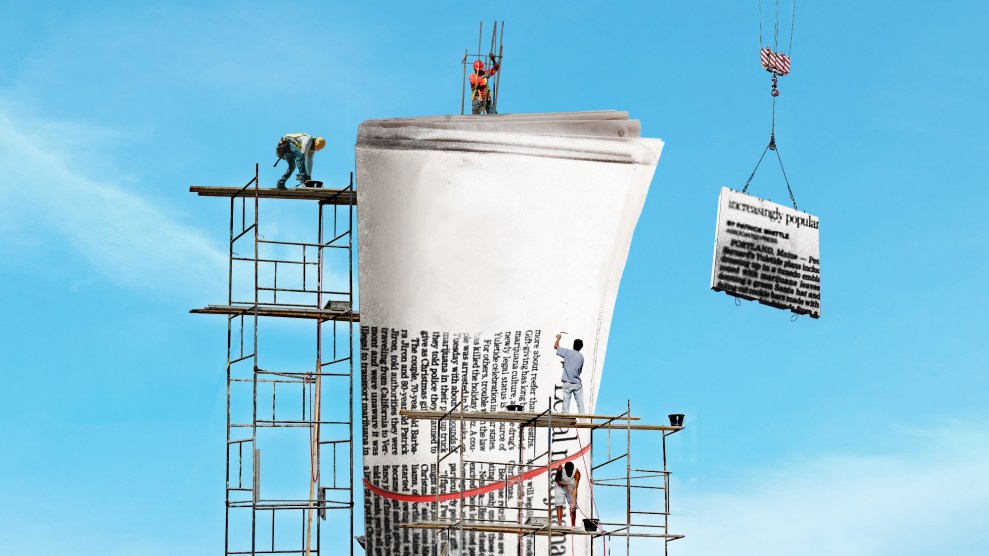
Illustration: Erik T. Johnson
“Why in God’s name would you use this material?” asks former Pentagon analyst Edward Block. He’s referring to Kapton, a plastic film often used to insulate wire. “It’s like having dynamite in your suitcase.”
Block is a wiring expert who is among those responsible for banning Kapton in most military aircraft because of its propensity to erupt into flames. That was in the 1980s. In the 1990s, the Coast Guard eliminated Kapton from its helicopter fleet, NASA grounded the shuttle fleet for five months while inspecting damaged Kapton wire, and the Clinton administration called aging Kapton wiring an issue of “national concern.” The Australian, Israeli, and Canadian governments have all investigated and in many cases prohibited its use in their planes.
So why is Kapton still in millions of Ford cars, trucks, and SUVs?
Since the early 1990s, the company has used this DuPont-manufactured material in the hydraulic pressure switch that shuts off cruise control when drivers hit the brakes. Coated with Teflon, Kapton serves as a barrier between the flammable brake fluid and the electric current just millimeters away. Yet years of use can cause cracking in the Teflon, leaving the Kapton membrane and the switch itself vulnerable to ignition from the current—which, in Ford vehicles, continues even when the engine is off. “Imagine your insulating material,” Block says, “which is designed to hold in or contain current, acting like a sparkler.”
In the past seven years, the National Highway Transportation Safety Administration (NHTSA) has investigated the role of these switches in more than 500 blazes that have ravaged cars, houses, and garages, and reportedly killed at least one person. The agency analyzed 260 cases of fires in Ford sedans—Crown Victorias, Lincoln Town Cars, and Mercury Grand Marquises—with model years between 1992 and 1997. In 1999, the company recalled nearly 300,000 of those vehicles. And by March of last year, the NHTSA had received more than 200 complaints of fires in Ford trucks—F-150 pickups, Expeditions, and Lincoln Navigators—with model years from 1995 to 2002. But Ford maintains that the root cause of the fires is too complex to fault a single component.
Although the automaker acknowledges evidence of overheating in the cruise-control components in some models—attributing it to a “systems interaction” of leaking brake fluid, Teflon corrosion, age and mileage, plus the location of the switch—it has recalled less than a third of the vehicles with the Kapton switches. Gail Chandler, a spokeswoman for Texas Instruments, which manufactures the switches, insists they’re safe. “We don’t think there’s anything wrong with the switch itself or with Kapton,” she says. “We’ve thoroughly tested these products and have not found there to be a problem.”
Ford spokeswoman Kristen Kinley agrees. “We do not believe the switch is the root cause of these under-hood fires,” she says. “Therefore, the Kapton also is not the issue.”
Last September, the NHTSA made some headway, as Ford contacted owners of 3.8 million of its vehicles, asking them to go to local dealerships to have their cruise controls disconnected. Eventually, they could have the feature restored with a new part installed that would act as a circuit breaker in case of overheating. The recall was the fifth largest in American automotive history, but it still leaves 11 million cars and trucks with Kapton switches on the road.
The investigation continues. A two-year NHTSA study of Ford sedans with switch fires stressed that cracking in the Kapton barrier was caused by wear and abnormal stresses during the manufacturing process. NHTSA spokesman Rae Tyson won’t speculate on Kapton’s role in the current investigation, maintaining that dozens of engineering and environmental variables are involved. “We really do need to understand the root cause of failure, and we aren’t there yet,” he says.
Nearly 30 years after the Ford Pinto fiasco was exposed by this magazine, consumer advocates are now confronting Ford for being slow to address this known fire threat. Ralph Nader chastised the automaker in early September: “Ford Motor Company’s sluggish and piecemeal approach to its automotive responsibilities betrays motorists’ safety. If this part has now been recalled on three separate occasions, why isn’t it simply removed from the fleet?” In an open letter to Ford CEO William Clay Ford Jr., Nader added: “How much longer will you allow this $20 part to imperil the public?”















